Ceramic coating has long been celebrated for its ability to provide robust protection and a glossy finish to various surfaces, primarily automotive paint. Yet, a common question arises in the realm of detailing: can you ceramic coat plastic?
In this exploration, we will delve into the possibilities, advantages, and considerations of applying ceramic coatings to plastic surfaces. Let’s unlock the potential and discover if plastic can indeed benefit from the power of ceramic coatings.
Can you Ceramic Coat Plastic?
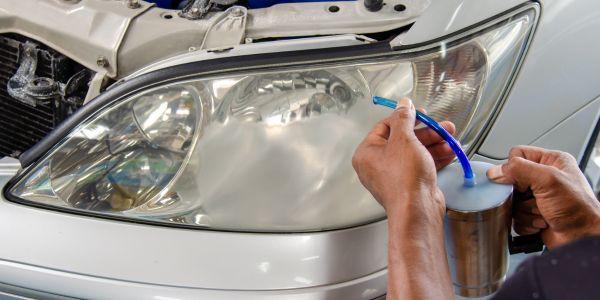
Yes, you can ceramic coat plastic surfaces. Ceramic coatings are not limited to just automotive paint; they can also be applied to various plastic surfaces, including trim, headlights, and even interior components. Ceramic coatings can enhance the appearance of plastic, provide UV protection, and make surfaces easier to clean and maintain.
However, it’s essential to properly prepare the plastic surface and choose a ceramic coating product suitable for plastics to achieve the best results. Additionally, consider that the longevity of ceramic coatings on plastic may vary compared to their performance on automotive paint.
Can Ceramic coating exterior plastics be used in cars?
Yes, ceramic coating can be used on exterior plastics in cars. Ceramic coatings are known for their ability to provide a protective layer on various surfaces, including plastic trim, bumpers, and other exterior plastic components.
When applied correctly, ceramic coatings can enhance the appearance of plastic surfaces, protect them from UV damage, and make them easier to clean. However, it’s essential to follow proper preparation and application procedures, including thorough cleaning and surface decontamination, to ensure the coating adheres well to the plastic and provides the desired results.
Can ceramic coatings be used on all types of plastic?
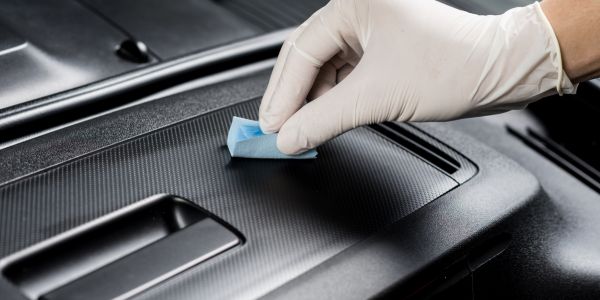
Ceramic coatings can be used on various types of plastic, but their effectiveness may vary depending on the specific type of plastic and its condition. Some plastics are more porous or textured than others, which can affect how well a ceramic coating adheres and performs.
Here are some considerations:
Smooth, Non-Porous Plastics: Ceramic coatings generally adhere well to smooth, non-porous plastics, such as automotive paint, clear plastics, and certain trim pieces. These surfaces typically provide an excellent base for ceramic coatings to bond effectively.
Textured or Porous Plastics: Textured or porous plastics, like some types of textured bumpers or trim, may pose challenges for ceramic coatings. These surfaces can be less receptive to coatings, and the coating may not provide as smooth a finish.
Preparation Matters: Proper surface preparation is crucial when applying ceramic coatings to plastic. Thoroughly clean and decontaminate the plastic surface to remove any dirt, oils, or residues that can hinder adhesion.
Specialized Ceramic Coatings: Some manufacturers offer ceramic coatings specifically formulated for use on plastics. These coatings may have modified properties to enhance adhesion and durability on plastic surfaces.
Before applying a ceramic coating to plastic, it’s essential to check the manufacturer’s recommendations and consider the specific type and condition of the plastic surface. While ceramic coatings can provide benefits for many plastic surfaces, results may vary, and some plastics may require more specialized coatings or additional preparation steps for optimal performance.
Can nano ceramic coatings be used on plastic?
Yes, nano ceramic coatings can be used on plastic surfaces. Nano ceramic coatings are known for their versatility and can be applied to various materials, including plastic. When properly applied to plastic surfaces, nano ceramic coatings can provide several benefits:
Enhanced Appearance: Nano ceramic coatings can enhance the appearance of plastic surfaces, giving them a glossy and well-maintained look.
UV Protection: These coatings offer UV resistance, which helps protect plastic surfaces from sun-induced fading and degradation.
Hydrophobicity: Nano ceramic coatings create a hydrophobic surface, making it easier to clean and preventing water spots and stains from adhering to plastic.
Longevity: Ceramic coatings are known for their durability, and they can provide long-lasting protection for plastic surfaces.
To achieve the best results when using nano ceramic coatings on plastic, it’s essential to prepare the surface properly. Thoroughly clean and decontaminate the plastic to ensure good adhesion. Additionally, some manufacturers offer ceramic coatings specifically formulated for use on plastic surfaces, which may provide enhanced adhesion and performance. Always follow the manufacturer’s instructions for the specific product you choose to achieve the desired results.
How long does ceramic coating last on plastic?
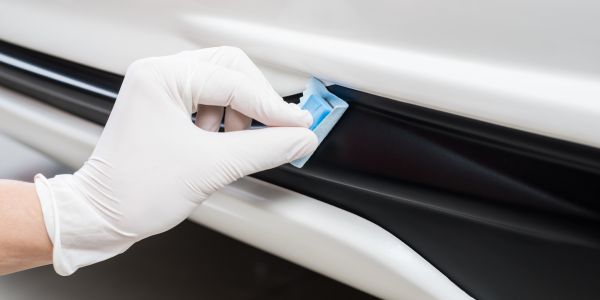
The longevity of ceramic coating on plastic can vary depending on several factors, including the quality of the coating, the type of plastic, and the environmental conditions the plastic is exposed to. In general, ceramic coatings can last on plastic surfaces for up to 1 to 2 years or longer with proper maintenance. However, it’s important to note that the durability of the coating on plastic may not be as long-lasting as on automotive paint.
Here are some factors that can affect the lifespan of ceramic coating on plastic:
Quality of the Coating: High-quality ceramic coatings tend to last longer than lower-quality ones. Investing in a reputable product can extend the lifespan of the coating.
Type of Plastic: Some plastics may be more receptive to ceramic coatings and provide better adhesion and longevity.
Maintenance: Regular maintenance, including washing and reapplication of a ceramic topper or maintenance spray, can extend the life of the coating.
Environmental Factors: Exposure to harsh weather conditions, UV radiation, pollution, and other environmental factors can affect the coating’s durability.
Proper Application: Following the manufacturer’s application instructions and ensuring proper surface preparation are crucial for maximizing the coating’s lifespan.
To maintain the protective properties and appearance of the ceramic coating on plastic, it’s advisable to monitor the surface for signs of wear, such as reduced hydrophobicity or diminished gloss, and reapply the coating or a maintenance product as needed.
3 reasons to use ceramic coating on car plastics
Using ceramic coating on car plastics can offer several benefits, but here are three compelling reasons to consider:
Enhanced Appearance: Ceramic coatings can significantly improve the appearance of car plastics. They provide a glossy, well-maintained finish that can make plastic trim, bumpers, and other components look new and refreshed. This enhanced appearance can contribute to the overall aesthetics of your vehicle.
UV Protection: Car plastics are vulnerable to UV radiation, which can cause fading, discoloration, and deterioration over time. Ceramic coatings offer UV protection, shielding plastic surfaces from the harmful effects of the sun. This UV resistance helps maintain the original color and finish of the plastics, extending their lifespan.
Ease of Maintenance: Ceramic coatings create a hydrophobic surface, meaning they repel water and contaminants. This property makes it easier to clean and maintain car plastics. Dust, dirt, and water spots are less likely to adhere to the coated surface, making routine cleaning more efficient and reducing the need for aggressive scrubbing.
In summary, using ceramic coating on car plastics can enhance their appearance, provide UV protection, and simplify maintenance, contributing to a well-maintained and visually appealing vehicle.
How to Apply Ceramic Coatings to Plastics?
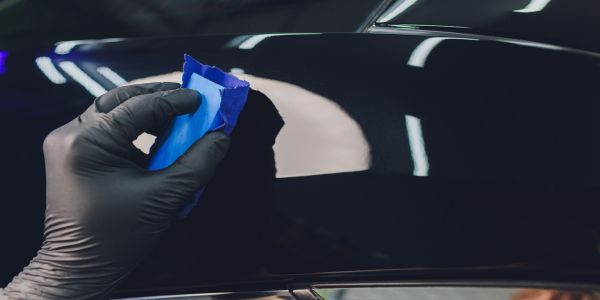
Applying ceramic coatings to plastics requires careful preparation and application to ensure optimal results. Here’s a step-by-step guide on how to apply ceramic coatings to plastic surfaces:
Materials You’ll Need:
- Ceramic coating product designed for plastics
- Applicator pad or microfiber cloth
- Isopropyl alcohol (IPA) or surface prep solution
- Clean microfiber towels
- Gloves and eye protection (for safety)
Step-by-Step Application:
Prepare the Surface:
Start by thoroughly cleaning the plastic surface to remove any dirt, dust, or contaminants. Wash the plastic with a gentle car wash soap and water, then rinse and dry it.
Surface Decontamination:
To ensure the surface is completely clean, use isopropyl alcohol (IPA) or a surface prep solution to remove any remaining residues or oils. Apply the IPA to a clean microfiber cloth and wipe the plastic surface.
Select the Right Ceramic Coating:
Choose a ceramic coating product specifically designed for use on plastics. Ensure it is compatible with the type of plastic you are coating.
Application Pad or Cloth:
Apply a few drops of the ceramic coating product to an applicator pad or a clean microfiber cloth. Avoid using excessive product.
Apply the Coating:
Working in small sections, apply the coating to the plastic surface using gentle, overlapping motions. Ensure even coverage without streaks or missed spots.
Allow to Cure:
Follow the manufacturer’s recommendations for the curing time of the specific ceramic coating product. This usually ranges from a few minutes to several hours.
Check for High Spots:
After the curing time, inspect the coated surface for any high spots or excess product. High spots may appear as streaks or uneven areas.
Buff and Finish:
Using a clean, dry microfiber towel, gently buff the coated surface to remove any high spots and reveal a smooth, glossy finish.
Repeat if Necessary:
Depending on the specific product and desired level of protection, you may choose to apply multiple coats of ceramic coating. Follow the manufacturer’s recommendations for layering.
Final Inspection:
Allow the coated surface to cure fully, typically for at least 24 hours, before exposing it to moisture or environmental elements. Conduct a final inspection to ensure the desired results have been achieved.
Remember to follow the manufacturer’s instructions provided with the ceramic coating product, as specific guidelines may vary among brands and formulations. Properly applied ceramic coatings can provide enhanced protection and aesthetics for plastic surfaces on your vehicle.
Explanation Guide: Can You Ceramic Coat Plastic?
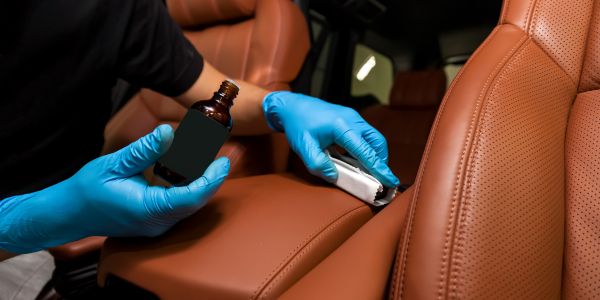
Plastic Materials in Common Use:
Plastic is a versatile and widely used material in various industries, including automotive, electronics, and household products. In cars, plastic components are commonly found in interior trim, exterior trim, bumpers, and more. Understanding the types of plastic materials used is essential when considering ceramic coating.
Advantages of Ceramic Coating Plastic Surfaces:
Ceramic coating offers numerous advantages when applied to plastic surfaces:
Enhanced Appearance: Ceramic coatings provide a glossy finish, rejuvenating the look of faded or weathered plastic.
UV Protection: UV-resistant coatings shield plastic from sun-induced fading and deterioration.
Hydrophobicity: Ceramic coatings make plastic surfaces water-repellent, easing cleaning and preventing water spots.
Scratch Resistance: They can enhance the resistance of plastic to minor scratches and scuffs.
Durability: Ceramic coatings can extend the lifespan of plastic, reducing the need for frequent replacements.
Prepping Plastic Surfaces for Ceramic Coating:
Proper preparation is crucial to ensure the coating adheres effectively:
- Clean Thoroughly: Wash the plastic with car wash soap and water, removing dirt, grime, and contaminants.
- Decontamination: Use isopropyl alcohol (IPA) or a surface prep solution to eliminate any remaining residues or oils.
- Surface Inspection: Check for imperfections or defects that may need addressing before coating.
Steps to Ceramic Coat Plastic Effectively:
Choose the Right Product: Select a ceramic coating product specifically designed for plastics.
Application Pad or Cloth: Apply a few drops of the coating to an applicator pad or clean microfiber cloth.
Apply Evenly: Work in small sections, applying the coating evenly with gentle, overlapping motions.
Curing Time: Follow the manufacturer’s recommendations for curing time.
Check for High Spots: Inspect the coated surface for high spots or excess product.
Buff and Finish: Gently buff the surface with a clean, dry microfiber towel to reveal a smooth, glossy finish.
Repeat if Necessary: Apply multiple coats if desired, following the manufacturer’s guidelines.
Final Inspection: Allow the surface to cure fully, inspecting for the desired results.
Ceramic coating plastic surfaces can transform their appearance, enhance protection, and extend their lifespan. Proper surface preparation and adherence to manufacturer instructions are key to achieving the best results.
Factors to Consider When Ceramic Coating Plastic Surfaces:
Compatibility of Ceramic Coatings with Different Types of Plastics:
Plastic Variety: Different types of plastics, such as polypropylene, polyethylene, and ABS, have varying levels of porosity and surface characteristics. Consider whether the chosen ceramic coating is compatible with the specific plastic material.
Surface Texture: Textured or porous plastics may require special attention during preparation and may yield different results when coated. Assess the compatibility of the coating with the texture of the plastic surface.
Research and Product Selection:
Ceramic Coating Type: Research and select a ceramic coating product explicitly designed for plastics. Ensure it offers the desired protective properties, longevity, and finish for your application.
Brand Reputation: Choose products from reputable manufacturers known for quality and performance in ceramic coatings. Read reviews and seek recommendations to make an informed decision.
Application Environment: Consider the environmental conditions the plastic will be exposed to, such as UV radiation, temperature extremes, and moisture. Choose a ceramic coating that can withstand these conditions.
Application Process and Specific Instructions for Plastic Surfaces:
Surface Preparation: Follow meticulous cleaning and decontamination procedures. The success of the coating depends on a clean and properly prepared surface.
Curing Time: Different coatings may have varying curing times, so adhere to the manufacturer’s recommended curing duration. Proper curing ensures the coating’s effectiveness.
Layering and Reapplication: Determine whether the selected coating requires multiple layers or periodic reapplication. Some coatings benefit from layering to enhance protection.
Maintenance: Understand the maintenance requirements, such as using pH-neutral or plastic-specific cleaners, to preserve the coating’s longevity.
Safety: Always prioritize safety by wearing appropriate protective gear, such as gloves and eye protection, during the application process.
By carefully considering these factors and following specific instructions for ceramic coating plastic surfaces, you can maximize the benefits of the coating and ensure long-lasting protection and aesthetics for your plastic components.
Pros and Cons of Ceramic Coating Plastic Surfaces:
Benefits of Ceramic Coating Plastic:
Enhanced Appearance: Ceramic coatings provide a glossy and well-maintained finish, rejuvenating the look of plastic surfaces.
UV Protection: Coatings offer UV resistance, shielding plastic from sun-induced fading and degradation, preserving the original color.
Hydrophobicity: Ceramic coatings make plastic surfaces water-repellent, easing cleaning and preventing water spots and stains.
Scratch Resistance: They enhance plastic’s resistance to minor scratches and scuffs, maintaining a pristine look.
Durability: Ceramic coatings can extend the lifespan of plastic, reducing the need for frequent replacements.
Potential Drawbacks or Limitations:
Application Challenges: Coating textured or porous plastics can be more challenging, potentially affecting the final result.
Limited Longevity: The durability of ceramic coatings on plastic may not match that on automotive paint, requiring more frequent reapplication.
Surface Preparation: Proper preparation is crucial, and any contaminants left on the plastic surface may affect adhesion.
Product Variability: The effectiveness of coatings can vary depending on the brand and formulation chosen.
Real-World Experiences and Testimonials:
Real-world experiences with ceramic coating plastic surfaces have yielded mixed reviews:
- Many users report significantly improved aesthetics, UV protection, and ease of cleaning.
- Some note that the results depend on proper preparation and choosing the right product.
- Users have experienced varied longevity, with some requiring reapplication after a year or more.
Ultimately, the effectiveness of ceramic coating plastic surfaces depends on factors like product choice, surface preparation, and the type of plastic. Real-world testimonials can provide valuable insights into individual experiences with these coatings.
FAQs
Is ceramic coating suitable for all types of plastic?
Ceramic coating can be applied to various plastic surfaces, but its effectiveness may vary depending on the type and texture of the plastic. It’s essential to choose a ceramic coating product specifically designed for plastics and consider the specific plastic material you intend to coat.
Can I apply ceramic coating to textured plastic surfaces?
Yes, ceramic coatings can be applied to textured plastic surfaces. However, applying the coating to textured plastics may require more effort and care to ensure even coverage and proper adhesion.
How long does ceramic coating last on plastic surfaces?
The longevity of ceramic coatings on plastic can vary depending on factors such as the product used, the type of plastic, and environmental conditions. In general, ceramic coatings on plastic may not last as long as on automotive paint. It’s advisable to follow the manufacturer’s recommendations for reapplication.
Do I need to prepare plastic surfaces differently for ceramic coating?
Yes, plastic surfaces should be thoroughly cleaned and decontaminated before applying ceramic coating. Proper surface preparation is crucial to ensure adhesion and the effectiveness of the coating. Follow the manufacturer’s instructions for surface preparation.
Can ceramic coating be applied to plastic trim, bumpers, and interior components in cars?
Yes, ceramic coating can be applied to various plastic components in cars, including trim, bumpers, and interior parts. It can enhance their appearance, provide UV protection, and make maintenance easier.
Are there any specific maintenance requirements for ceramic-coated plastic surfaces?
Maintaining ceramic-coated plastic surfaces typically involves regular washing with a pH-neutral or plastic-specific cleaner. Avoid using abrasive or harsh chemicals that could damage the coating.
Can I use traditional car wax on ceramic-coated plastic surfaces?
Using traditional car wax on ceramic-coated plastic surfaces is generally not recommended, as it may not adhere properly and could affect the appearance of the coating. It’s better to use products specifically designed for ceramic-coated surfaces.
Can I apply ceramic coating to plastic surfaces myself, or should I seek professional help?
Many ceramic coating products are designed for DIY application, but it’s essential to follow instructions carefully and ensure proper surface preparation. If you’re unsure or want the best results, professional application may be a viable option.
Are there any specific brands or products recommended for ceramic coating plastic surfaces?
Several reputable brands offer ceramic coating products designed for plastics. It’s advisable to research and select a product based on your specific needs and the type of plastic you intend to coat.
Can I apply multiple layers of ceramic coating to plastic surfaces for added protection?
Yes, you can apply multiple layers of ceramic coating to plastic surfaces if desired. However, follow the manufacturer’s guidelines for layering and curing times to achieve the best results.
Conclusion:
A. Recap of the Main Points Discussed: In this exploration of ceramic coating plastic surfaces, we’ve covered several key aspects:
- The compatibility of ceramic coatings with different types of plastics.
- Factors to consider when applying ceramic coatings to plastic surfaces.
- The benefits of ceramic coating plastic, including enhanced appearance and UV protection.
- Potential drawbacks, such as challenges in application and variable longevity.
- Real-world experiences and testimonials, highlighting both positive and negative feedback.
B. Final Thoughts on the Feasibility of Ceramic Coating Plastic Surfaces: Ceramic coating plastic surfaces can offer substantial advantages, including improved aesthetics, UV protection, and ease of maintenance. However, success depends on proper surface preparation, product selection, and realistic expectations regarding longevity. While ceramic coating may not provide the same durability on plastic as on automotive paint, it can still significantly enhance the appearance and protection of plastic components.
C. Try Ceramic Coating on Plastic with Proper Research and Care: For those considering ceramic coating for plastic surfaces, conducting thorough research and following manufacturer instructions is key to achieving the best results. While there are potential challenges, many users have reported positive experiences and benefits. With the right product and approach, ceramic coating can be a valuable addition to your plastic maintenance and enhancement toolkit. So, don’t hesitate to explore this option and enjoy the advantages it can bring to your plastic surfaces.